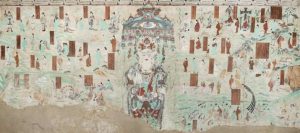Dr. J. Abraham Vélez de Cea was originally interviewed for Buddhistdoor en Español. The following is a translation of that interview.
Dr. J. Abraham Vélez de Cea has been a professor of Buddhism and world religions at Eastern Kentucky University (EKU) since 2006. Before joining EKU, he taught Buddhist ethics and Buddhist-Christian mysticism in the Department of Theology at Georgetown University in Washington, DC. He is an active member of The Society for Buddhist-Christian Studies and the Buddhist Critical-Constructive Reflection Group of the American Academy of Religion.
Vélez de Cea is the author of the book The Buddha and Religious Diversity (Routledge 2013), which analyzes the Buddha’s attitude toward religious plurality. He has also published several articles about interreligious dialogue and diverse issues of primordial Buddhist thought in specialized journals, including Philosophy East & West, Sophia, the Journal of Interreligious Dialogue, Buddhist Studies Review, the Journal of the International Association of Buddhist Studies, the Journal of Buddhist Ethics, and the Journal of Buddhist-Christian Studies.

Buddhistdoor en Español: In your opinion, what was the Buddha’s attitude toward other religious traditions?
Dr. J. Abraham Vélez de Cea: I have devoted many years to interreligious studies as my doctoral thesis was with Raimundo Panikkar (1918–2010), an expert and pioneer in interreligious dialogue. My interest developed from my training with Panikkar and from the importance of knowing more about other religions. It’s like looking at yourself in a mirror. A pioneer in the history of Western religions, Max Müller (1823–1900), said that he who knows only one religion knows none.
From a religious-philosophical viewpoint, the historical context of the Buddha is very diverse. Pali texts are essential for understanding religion in India in this era, around the fifth century BCE. In that time there was a tradition of wandering ascetics grouped as “followers of.” The Buddha led one of these groups. He was a master and, at the same time, was also learning from other masters such as Alara Kalama and Uddaka Ramaputta, with whom he learned meditation techniques with different states of jhana or concentration, specifically the immaterial attainments. However, the Buddha saw that one could not solve the problem of suffering via these techniques, meaning that while an extremely subtle and very pleasurable meditative state could be reached, one is not freed from suffering, which was what the Buddha was seeking. So he kept looking for other types of practices, such as the ascetic practices, fasting, retaining the breath, and others.
The Buddha’s attitude with all of these groups was to be open to dialogue without compromising what he understood as correct and true. The Buddha had a series of criteria about what was good and what was bad; that is, the Buddha was neither a relativist, nor was he dogmatic or a fundamentalist. In Pali texts we see that he was continuously in dialogue, which was inevitable as he traveled from city to city and from forest to forest, meeting with others in those areas who had the same lifestyle, the samanas (in Pali) or sramanas (in Sanskrit), who enjoyed these debates.

BDE: And toward Brahmanism?
AVC: The Buddha belonged to ascetic groups, but also—in the historical context—he was a contemporary of the Brahmanic tradition. Brahmanism is Proto-Hinduism. I would not speak of Hinduism in the Buddha’s time, as it is an anachronism and not historically correct. He met a series of people there from the Brahmin caste who had a view of the world and religion that, in those times, required the sacrifice of animals and had a highly static social structure, as it was not open to people who did not belong to a specific caste, all based on concepts of purity and impurity. Here the Buddha—normally open to dialogue—was seen to be critical. He took the ideology arising from Brahmanism and accepted it, but gave it a new meaning.
This act of taking a concept from another tradition and giving it his own meaning reveals the disposition that the Buddha had toward other religions, since he would not have done so if he were a dogmatic fundamentalist. Indeed, there is a beautiful text that says that when we disagree about something, we shouldn’t talk about it, instead try to talk about what we have in common.
When there were debates, what the Buddha did was establish dialogue. For example, when they spoke of the purity of the Brahmin, the Buddha suggested that they have to wash like everyone else, that their women menstruate like all other women, and so forth. This showed them that the concept of purity based on the caste in which you were born did not correspond with the facts, since a Brahmin is someone who reaches ethical-spiritual purity regardless of whether or not he was born into a caste or belongs to it. This completely relativizes Brahmanism, since, according to this view, the entire world has access to the ideal of being a Brahmin.
It is very difficult, if not impossible, to find a situation in which the Buddha denigrated people from other schools. There is an example of this that I think is very significant. In the last conversation the Buddha had with a member of another school (detailed in the Mahaparanirvana Sutta), the Jain ascetic Subhadda approached the Buddha on his deathbed and asked him, “There are many masters who teach disciplines different than yours . . . do they live in truth or not?” And the Buddha answered, “Stop these questions and let me teach you the Dharma: . . . When you can find the Noble Eightfold Path in a tradition or school, then you can say that there are ascetics in this school who have reached supreme states of liberation, but you will not find it in schools where there is no noble eightfold path . . .” In other words, he was giving him a criterion, which is a principle of conditionality:
If P (the Noble Eightfold Path),
then Q (liberation).
I am publishing this argument because these words of the Buddha have not been interpreted well. I think it suffices to turn to the conditional criterion: if there is no Noble Eightfold Path, then these schools are empty of ascetics who have reached liberation.
The Buddha was critical of Brahmanism because he relativized the gods: they were no longer beings who freed or helped along the spiritual path; they didn’t need to be offered gifts to pacify them or to attain goods of a mundane nature. The Buddha was criticized for employing irony on one occasion on the bank of a river. When another ascetic was invoking the gods to help him cross the river, the Buddha made him see that this was silly as the gods were not for this purpose. This has been used to interpret the Buddha as an ironic atheist, like Stephen Batchelor does, although I believe there are other possible interpretations.
The Buddha reinterpreted the gods as not being savior figures to whom to offer praise and sacrifices. The Buddha was very clear about this. In the Digha Nikaya [collection of long discourses], he analyzes all the sacrifices that were made in his era and, in the end, declares that the supreme sacrifice is no more and no less than leading an ethical and spiritual life.
I will give another example: when Upali, a Jain, declared that he was a disciple of the Buddha after losing a debate, the Buddha told him: “Please do not stop supporting and making offerings of food to the Jain monks and . . . keep on investigating; make sure you keep investigating.”
BDE: What are your future projects?
AVC: I have a book coming out on Buddhist attitudes toward other religions from the viewpoint of Tibetan Buddhism and Theravada Buddhism, in which Bhikkhu Bodhi wrote one chapter and I wrote another one. It will be published by Equinox and I think it should be in bookstores in 2020, to name one of the various projects in which I am involved.
See more
The Buddha and Religious Diversity (Routledge)














